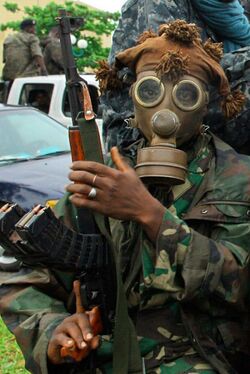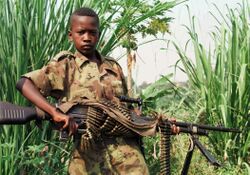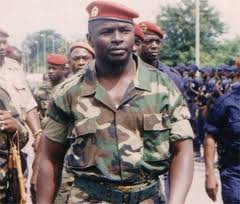Third Asemese Civil War
The Third Asemese Civil War was an Internal Conflict within Upper Asema from 1993 until 2002. The conflict killed roughly 500,000 people and saw intense international peacekeeping efforts in an attempt to stop large scale crimes against humanity. The conflict ended with the Nelson Peace Accords in 2002, however many scholars see the 2003 Asemese Remobilization Crisis and the 2003 Asemese Coup d'état as continuations of the war.
After the end of the Second Asemese Civil War President Sylvester Alyhé would preside over a period of relative peace, ALINU would reform into the Upper Asemese National Army and continue Counter-Insurgent operation in the countries far east. Rebel forces who were allied to former President Blaise Jeannot Blé would reform in the Far-East where Blé's political base was strongest. This loose coalition of armed rebels would broadly support Timothé N'zwou, former Army Chief of the Upper Asemese Army under Blé. These verious forces would mobilize in response to the Bohobohé Massacres which saw several thousand ethnic Minga, Kinsà, and Gregbasa killed by Government forces under the auspice of Alyhé's anti-Rebel Policy.
Between 1993 and 1995 Rebel forces would sweep through much of the eastern and southern departments. Placing the capital Jacqueville undersiege. But an Army victory at Jacqueville in late 1996 would break the siege and diminish the rebels tactical possition. One of the deciding factors in the Siege of Jacqueville was the use of Mai-Mai. Initially used to donate independent community defense forces. The term came to be used more broadly to describe militant forces which acted at the local level, broadly apolitical and chose sides based on tribal, community, or economic intrests. Many Mai-Mai were in urban areas formed from local criminal gangs, while in rural areas the term Mai-Mai could be used to describe Bandits and hyperlocal community defense forces. Mai-Mai forces would be utilized by all sides in the conflict and would also act independently.
In 1995 Rebels affliated with the Mosquito Squad would assault a government convoy transporting President Alyhé. The Mai-Mai would and dismember him with Machetes, a local media team who had been allowed to film with the Mosquito Boys caught the event on film, smuggling it out of country where it would make international headlines. With the death of Alyhé, his Vice President Jean-Pierre Dweh would assume the presidency and continue to fight the rebels.
Operation Lionne would see government forces make ground deep into rebel held territory, attempting to liberate the city of Symphoreville, However the governments elite troops, the 100th Air Cavalry Brigade would defect, doing so because the units soldiers had not been paid in nearly a year. this mutiny was led by Colonel Jean-Évangéliste Belehyi. The soldiers would rename themselves the Kobra Kommandos and would switch sides to support N'zwou. this stalled the Operation. Rebels would counter attack in 1997 and would reverse most government gains in the east during Operation Coup de Marteau.
Belehyi's forces would prove important for changing the tide of the war. the Kobra Kommando's would help push government forces closer to Jacqueville, leading to the 5th Siege of Jacqueville in 1998. In the North, N'zwou's NULT forces would strike, forming an alliance with the NCAPDGb, as well as establishing the Bataillon du Petit Peuple to take over the city of Sinké-Pacifique. This led to the Purification Campaign, a series of mass killing which depopulated the city of much of its non-Gbenende population, one of the largest cases of genocide during the war.
a large peacekeeping presence would be sent to Upper Asema in the aftermath of the Purification Campaign in Sinké-Pacifique, with N'zwou using child soldier's to combat Peacekeeping forces. However N'zwou would be killed in fighting near Gnaka later that year. Belehyi would take over as the dominant rebel force. Dweh and Belehyi would meet for Peacetalks in Nelson, Thalassic Federation sponsered by them President TBD. These Talks would lead to the signing of the Nelson Peace Accords in 2002, which would establish a powersharing agreement between the rebels and government and set a framework for demobilization of the Mai-Mai as well as setting a road map for Elections and transitioning former rebel groups into political parties.
This would be the last Widescale conflict in the country, however unresolved issue like Gbaysian Autonomy, Neo-Mai-Mai rebels in the hinterlands, and unresolves socio-economic grevinces in the Dzogonda Department would lead to a series of smaller conflict's. Dweh would remain President and Belehyi High Commissioner until Belehyi would oust Dweh in a Coup d'état following the 2003 Asemese Remobilization Crisis. The conflict saw major Human Rights Abuses up to and including genocide. nearly 50,000 children between the ages of 7 and 15 would participate in the war as Child Soldiers, The conflict also saw institutionalized Sexual Violence used as a weapon of war. Mutilations were common with nearly 75,000 people having their hands, feet, or other body part cut off as a way to prevent then from continuing to fight. Anthropologist and historians have describe it as "one of the most devestating conflict in recent history" for the level of society wide destruction it brough.
Background
Alyhé takes power and aftermath of the Second Civil War
Alyhé's ALINU forces would take control of the national government in 1989, Deposing Blaise Jeannot Blé and his Authenticity Front of Asemese Democracy led government. Alyhé would take up the title as president and inagurate a new Unity Government made up of high ranking ALINU members and what were called "Reformed Tyrants", former administrators in the Blé administration who had in some way reconciled with the new government. This was done to maintain important administrative bureaucrats as well as to dampen any pro-Blé uprisings. The figurehead of this group of politicians was Perceval Tancrède Sorokonè, who served as Chairman of the National Assembly. The political balance struck by Alyhé wouldd last unopposed in the south-west and north of the country. Important figures like Cléas Twe and Dieudonné "Didi" Oupamfo would be instramental in keeping political violence down in the rebelious east.
Early in his administration tension mounted between so called Originalist, who felt that Alyhé's pragmatic governing style had drifted away from the stated goals of ALINU and invalidated much of the sacrifice made during the war. This was opposed by Alyhiste who themselves felt supported the president's governing style in the wake of the war. These tensions would come to a head in late 1990 when elements of the National Assembly and Armed Forces would conduct the 1990 Upper Asemese Coup Attempt. Led by Assemblyman Jean-Zénobe Macca the forces would attempt to secure key infrastructure, using unarmed tanks in an attempt to scare off police as the main force marched to the Presidential Palace. The tank would drive off the Raphaël Ngwamba Bridge, drowing its crew of 4. The others would continue to march but would be fought back by policemen. The coup would be labled a disaster and Macca would be arrested.
In the east, the coup was viewed possitively and with enthusiasm. Macca was an ethnic Dwèmè just like Blé and his coup was seen as a sign of disloyalty amongst the Dwèmè people. Alyhé would go through and establish the Anti-Terror Units, who would be used to attack Dwèmè communities suspoected of abeding militant activity. These forces would be used to conduct raids on suspected militants, but in practice served as "Ethnic Death Squads" occording to Anthropolgist Jean-Luc Bellemy.
Ethnic Tension in the East
Tensions had been growing in the Tsitowodzi Massif Region between ethnic Dwèmè and Gbenende, Sorhoro, and Yamende people's. These conflict have been the result of the previous civil war where the Gbenende, Sorhoro, and Yamende formed verious civil defence forces to help ALINU in its war against the Blé Government. One aspect of the conflict was ALINU allied Sorhoro forces going in and attacking Dwèmè communities, using hand mutilation to prevent local Dwèmè men from joining local government forces. The Gbenende, Sorhoro, and Yamende would form the Kparèsorh Mai-Mai in 1989 in the aftermaath of ALINU's victory. Dwèmè communities in the region would follow, forming several Mai-Mai's, the largesting being the Montagnard Mai-Mai.
The Montagnard's would attack several Yesohro villiages, killing several hundred villiagers as the Kparèsorh attempt to mobilize in response. The villiages of Baulo, Zaguer, and Solon would be razed and burned by Montagnard forces, with little to no resistence. This would cause a reciprocal cycle of violence between these two groups, the national army would be sent in to try and maintain peace. However in many cases the National Army would not intervine in instences of violence against Dwèmè communities while violently suppressing Dwèmè militants. In august of 1990 the national army would be pushed out of the Bingué Department by Dwèmè Mai-Mai forces. The army would attempt to retake the Department by force.
From November to early December The national army would get explicite orders from President Alyhé to use extreme force to regain control of the Department. This would lead to the Battle of Ludolpheville where Mai-Mai forces would be forced out of the Departmental Capital of Ludolpheville and would see the National Army purge the city of its Dwèmè population. The army would however be stopped by Mai-Mai forces north of the city along the Fùlùnè Forest. President Alyhé would order General Louis-Auguste Bêléa to pull his forces away from the forest.
Anti-Rebel Operations
In the aftermath of the the Battle of Ludolpheville the Alyhé Government would formulate a new stratagy in more effectively dealing with the Rebelious East. The pro-Government tribal militias would be reformed into the Anti-Terror Units, led by High Commissioner Cléas Twe. The goal of the Anti-Terror Units was to form a localized anti-militia formations based on loyal ethno-tribal people's. Twe would form the Anti-Terror Unit around his personal militia based in the Far-Eastern City of Dengubé.
The ATU's would strike at anti-Government Mai-MAi forces near the Fùlùnè Forest. The Battles in the Forest would see the ATU push back Mai-Mai forces out of the forest and into the urban centers of Yémngè, Gnadawlah, Wuhôro, and Bohobohé. On the 3rd of January 1991 ATU forces under the command of Twe would assault Yémngè and Gnadawlah. The ATU's would force their way into the south of Yémngè, while another unit would wedge themselves in between Yémngè and Gnadawlah before entering both towns from the north and south respectively.
Timothé N'zwou and NULT
Bohobohé Massacres and Rebel Mobilization
Rebel Offensive 1993-1995
Battle of Gola
Dwèmè vs Kpalo Ethnic Conflict
FRONALIDEM Formation
Dzonganda Rebelion
Southern Offensive
Siege of Jacqueville

Mai-Mai Normalization
Rebel Defeat at Jacqueville
Assassination of Alyhé

1995-1997 Government Offensive
Operation Lionne
Battle of Symphoreville
Defection and Belehyi's Kobra Kommandos
1997 Rebel Counter Offensive
Conflict from 1997-1998
Belehyi's Southern Offensive
5th Siege of Jacqueville
Mai-Mai Internal Conflict in Jacqueville
Opperation Guerrier Volant and the Battle of Éphraïm Wreh International Airport
N'zwou's Northern Offensive
NCAPDGb Participation
Battle of Sinké-Pacifique
The Purification Campaign and Genocide
International Peacekeeping Efforts
Gnaka and Death of N'zwou
Peace Talks
1998-2002
Battle of Mané
Establishment of the Womans Force for Peace and Stability
Establishment of Safe Zones
Retreat from Jacqueville
Stalemate in the South
Nelson Peace Accord
End of the Conflict and Demobilization







